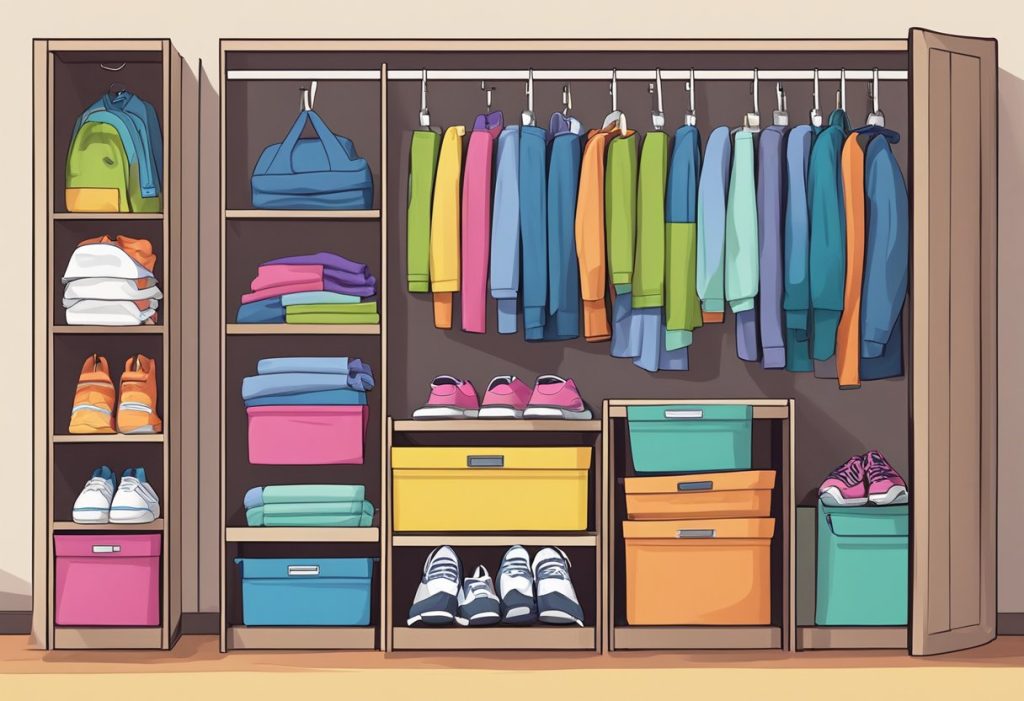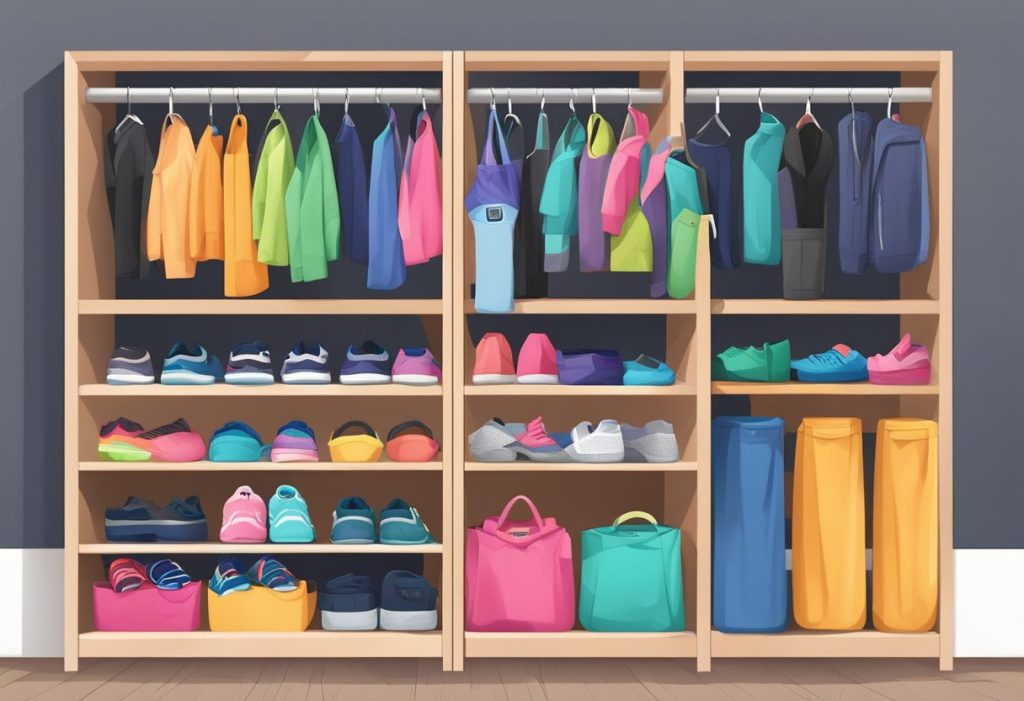
Knowing how to organize workout clothes can revolutionize your fitness routine and significantly boost your motivation to exercise. Imagine the ease of grabbing your gear without the hassle of rummaging through a jumbled pile.
With a few smart strategies, your activewear will be ready for action, making pre-gym prep a breeze and post-workout storage a quick task. This level of organization not only simplifies your routine but also serves as a constant motivator. When your workout clothes are neatly sorted and easily accessible, it’s a visual and mental cue that keeps you focused on your fitness goals. So let’s dive in:
What Are the Basics of Organizing Workout Clothes?

Organizing workout clothes effectively comes down to understanding their importance in your fitness routine and recognizing the different types to categorize them smartly.
Importance of Keeping Workout Clothes Organized
Keeping your workout clothes organized can save you time and help maintain the condition of your garments. Ensuring that clean clothes are easily accessible streamlines your preparation for exercise sessions. On the other hand, properly storing used workout attire until laundering can prevent odor and mildew growth in your living spaces.
- Accessibility: Quickly find what you need, preventing delays in starting your workout.
- Maintenance: Proper organization discourages fabric wear and tear.
Types of Workout Clothes
Your workout attire can vary based on the activity and climate. Differentiating between them is essential for organization.
- Compression Wear: These items, like leggings or sleeves, are designed to support muscles during exercise.
- Moisture-Wicking Gear: Typically made from synthetic fibers, these garments help keep you dry.
- Insulated Layers: Used for cold-weather workouts, they help maintain body heat.
- Breathable Outfits: Often used in warmer climates for better air circulation.
How to Organize:
- Compression Wear and Moisture-Wicking Gear: Store these together since they’re often used in similar workout scenarios.
- Insulated Layers: Keep in a separate and easily identifiable area, especially if you live in an area with variable climates.
- Breathable Outfits: Have these ready to grab for high-temperature days or intensive cardio sessions.
By recognizing these types, you can create designated spots in your storage for each, streamlining your process of getting dressed for the gym and caring for your clothes post-workout. Understanding that each type has specific storage needs is key to longevity and ensuring that you’re always ready for your next workout session.
How To Organize Workout Clothes By Decluttering and Allocating Space

To efficiently organize your workout clothes, begin by dedicating a specific area and removing items that no longer serve your needs or fit your lifestyle.
How Can I Allot Dedicated Space for My Workout Clothes?
Allocating a dedicated space for your activewear is essential to maintaining an organized wardrobe.
Firstly, identify a section within your closet or a drawer exclusively for your fitness attire.
Fold your clothes and arrange them standing up, not flat. This way, you can quickly see and pick out what you want without having to search through a stack.
Use open boxes for things like leggings, shorts, and sports bras that don’t stay folded well. Without the lids, you can spot what’s inside right away.
Keep little things like hair ties and socks in drawers to keep them neat and sorted.
Consider adding dividers or small bins to separate categories like tops, bottoms, and sports bras, making selection and retrieval effortless.
What Is the Best Way to Declutter My Activewear?
Initiate the decluttering process by laying out all your activewear.
Examine each piece critically, and organize your workout clothes by deciding what to keep, donate, or discard.
Dispose of items that are torn, don’t fit, or haven’t been worn in over a year. Be honest about what aligns with your current fitness goals and style preferences.
After decluttering, your activewear collection should include only functional pieces, that fit well, and inspire you to stay active.
Storing Your Activewear

When organizing your activewear, consider the fabric, functionality, and frequency of use to determine the best storage methods.
This will not only keep your gear in top condition but also save you time when getting ready for a workout.
Efficient Storage Methods
For items like leggings, shorts, and sports bras, utilize drawer dividers or smaller boxes without lids to keep everything visible and easily accessible.
Hanging storage is optimal for pieces such as jackets or items you prefer not to fold.
For various types of tops and pants, shelving or stacking is recommended, as you can group similar items.
In summary:
| Storage Type | Ideal Use |
|---|---|
| Drawer Dividers/Bins | Best for keeping small items contained. |
| Hanging Storage | Ideal for items prone to wrinkling. |
| Shelving | Suitable for items that are folded and stacked. |
How To Store Sweaty Workout Clothes Properly
Immediately after a workout, it’s crucial to air out sweaty clothes to prevent odour and bacteria growth.
Before storing them, ensure they are completely dry. If unable to wash them right away, hang them in an area with good airflow or use a dedicated hamper that allows for ventilation.
- Air Dry: Hang sweaty clothes to air out post-workout.
- Dedicated Hamper: Store pre-wash activewear separate from other laundry.
Specialized Organizing Tips

In this section, you’ll gain insights into structured approaches for managing your workout attire, focusing on the diversity of your gear and the efficiency of colour-coding and folding techniques.
Organizational Tips for Various Gear
Drawers and Dividers: Utilize drawer dividers to separate small items like socks and hairbands.
This approach ensures each item has a designated spot, minimizing clutter. For smaller objects, storage in drawers is practical, allowing you to maximize space and maintain order.
Hanging Solutions: Use slim, non-slip hangers for items you prefer not to fold, such as jackets or yoga pants. This method prevents wrinkles and keeps items easily accessible.
Baskets and Bins: Assign baskets or bins for bulky items like sweatshirts and track pants. Clearly label these containers for quick identification, and place them on lower shelves for easy reach.
Color Coding and Folding Techniques
Color Coordinated System: Implement a color-coded system for your workout attire. This strategy simplifies the process of finding the right outfit and motivates you to maintain an organized wardrobe.
Effective Folding Methods:
- T-shirts and Tanks: Fold them using a consistent pattern and stack them vertically side by side.
- Leggings and Shorts: Roll them tightly to save space and prevent creasing. Align these rolls in rows inside a drawer or a bin.
FAQs on Organizing Workout Clothes
What is the best way to organize gym clothes?
Start by sorting your clothes by type — leggings, shorts, tops, etc. Use drawer dividers or shelves for separation, and fold garments neatly to maximize space and visibility.
How do you manage gym clothes?
Manage your gym clothes by washing them immediately after use, sorting them into dedicated storage spaces, and keeping a separate bag for used garments to maintain hygiene.
Should I hang my workout clothes?
It’s acceptable to hang certain workout clothes that are prone to wrinkling, such as tank tops or technical fabrics. For items that can stretch out, like sports bras or leggings, folding is recommended.
Where do you put workout clothes?
Allocate a specific section in your closet or dresser for workout clothes. If space is limited, consider under-bed storage containers or a separate wardrobe organizer.
Is it OK to wear workout clothes in public?
Wearing workout clothes in public is generally fine; they are designed for comfort and are widely accepted as part of today’s casual wear.
How many workout clothes should you have?
The amount of workout clothes you should have depends on your exercise frequency but having at least three to five sets allows for a rotation between laundering without running out of clean gear.
Final Thoughts on Maintaining an Organized Workout Wardrobe
To master how to organize workout clothes, prioritize decluttering and designate a specific area for each item. Use accessories like pegboards for space-efficiency and habitually reassess to keep your fitness attire in check. Witness the ease in your routine with a structured wardrobe.